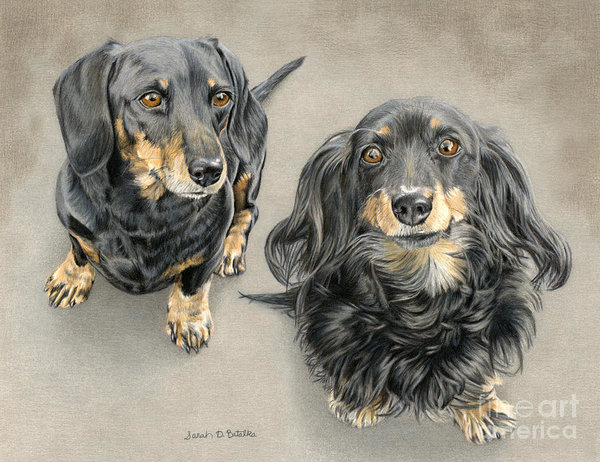
While political cartoonists commonly used images of the Dachshund to ridicule Germany during war, the breed was quite dear to Germans. They viewed with affection breed traits they saw as the embodiment of Teutonic qualities: Reliability, courage, obstinance, somewhat conservative, and a little nosey. A few years back, Udo Kopernik, then the spokesman for the German Dog Federation, was quoted as saying with regards to the breed: “There’s his legendary stubbornness and resilience, which is something he needs if he is to confront a fox or a badger underground. And there’s also a certain degree of megalomania. That makes the Dachshund very charming.”
We particularly liked a quote from Vinzenz Ölgemöller, Dachshund breeder, and honorary chairman of the Ibbenbüren Dachshund Society in northwestern Germany. “When he doesn’t feel like doing something he’ll just sit there staring you out, he’s a philosophy unto himself.”
The Dachshund, as closely connected with Germany as its beer and sausages, is considered a symbol of Germany, and indeed, when the 1972 Olympic Games were held in Munich, a Dachshund named “Waldi” was the mascot. The breed was the most popular breed in Germany in the 1970s and 1980s, followed by German Shepherd Dogs, though that flipped in the 1990s when German Shepherds took the lead, probably because of the TV series “Inspector Rex.”
Still, the news that came in 2008 was surprising. The Dachshund was in trouble. The German Dog Federation said that the births of Dachshunds registered by German breeders had slumped 35 per cent over the past decade. Only 7,300 Dachshund pups were born in 2005 as compared to 12,000 whelped in 1996, and a whopping 28,000 pups in 1972 (perhaps an “Olympic bump”). Ölgemöller, however, remained optimistic. “He’s such an individualist that he’ll survive this downturn and will remain a German national symbol.”
Perhaps Ölgemöller got it half right. Last year, the Dackelmuseum in Germany opened its doors, probably the only museum devoted entirely to the Dachshund, and while the number of Dachshunds more than doubled in the past ten years, the surge was in Great Britain, not Germany. Kennel Club registrations surged 40 per cent since 2015 to nearly 9,000 new registrations in 2017, though that, too, was a cause of concern. A spokesman for The Kennel Club thought that “Stanley” had had a “major impact” on Dachshund ownership in the UK. Who was Stanley? Since January 2015, a miniature smooth haired Dachshund named “Stanley” has appeared on billboards, television and football stadiums across the country, the dog being part of the advertising for Vitality health insurance.
Stanley even shows up on the face of an Apple Series 4 watch.
Not surprisingly, then, the Dachshund leading the UK breed boom is the Miniature Smooth Haired variety with a record 5,735 registrations last year (the long haired version followed with 1,027 new registrations). Celebrity ownership also helped: The singer, Adele, and actors Christian Slater and Ashley Olsen both have Dachshunds.
It was a remarkable turnaround for a breed that during WWI was the object of ridicule and stone throwing assaults in the streets. Balance dictates that in time, things will level out, but here’s hoping that until that happens, substandard breeders won’t flood the country with unsound dogs.
Image: “The Long And Short Of It” by Sarah Batalka is available as art, lifestyle items and home decor here. You may also find her on Society Six,
